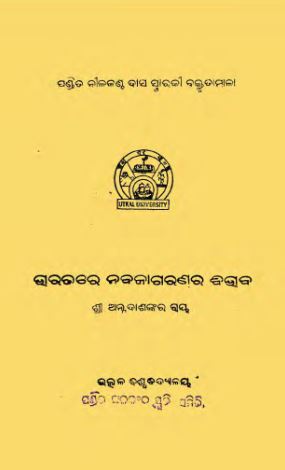Bharatare Nabajagaranar Bibhaba (translated as “The Essence of Renaissance in India”) is a profound and impactful work by the distinguished Bengali writer Annada Sankar Ray, meticulously translated into Odia by B. Mohanty. Published in 1981, the book serves as a quintessential guide to the socio-cultural and intellectual revival that swept across India – a phenomenon often referred to as the Indian Renaissance. This essay collection not only maps the transformative period but also delves into the contributions of various notable figures who played pivotal roles during this epoch.
Annada Sankar Ray’s original narrative, brought vividly to life in Odia by Mohanty, captures the essence of a period marked by profound awakening and enlightened thought. Ray meticulously analyzes the multi-faceted dimensions of the Indian Renaissance, portraying it as a vibrant amalgamation of reawakened national consciousness, reclamation of cultural identity, and intellectual rejuvenation.
Ray’s erudition is reflected in his grasp of historical context and his ability to draw connections between disparate events and personalities that collectively contributed to this epoch. The essays explore the influences of Western education, the intertwining of traditional Indian values with modernist ideas, and the socio-political undercurrents that spurred reform and revolutionary thought.
One of the most poignant sections of the book is Ray’s tribute to the towering figures of the Indian Renaissance. He offers memorial sketches of seminal influencers such as Raja Ram Mohan Roy, Swami Vivekananda, Rabindranath Tagore, and others. Each essay provides deep insights into their philosophies, struggles, and their monumental impact on shaping the Indian ethos.
For instance, the narrative detailing Raja Ram Mohan Roy’s fight for social justice and his efforts to eradicate practices like Sati is both inspiring and informative. Similarly, Swami Vivekananda’s advocacy for a synthesis of spirituality and rationality is highlighted as a cornerstone for India’s philosophical discourse. Through these memorials, Ray presents a tapestry of vibrant characters who championed the cause of a modern, progressive India, while staying rooted in its rich cultural heritage.
Annada Sankar Ray’s rendition into the Odia language by B. Mohanty not only makes the work accessible to Odia readers but also adds a distinctive local flavor to the broader historical narrative. The translator’s adept skill ensures that the depth and nuances of Ray’s original text are preserved and enhanced, making the work resonate with regional significance.
Moreover, the book also weaves the story of Odisha’s own encounters and engagements with the renaissance movement. It traces the contributions of local intellectuals and reformers like Fakir Mohan Senapati and Madhusudan Das who were instrumental in the region’s own socio-cultural awakening. This regional context enriches the reader’s understanding of how the Indian Renaissance was not a monolithic occurrence but a confluence of multiple localized movements.
“Bharatare Nabajagaranar Bibhaba” stands out as an illuminating compendium that bridges the past with the present. Annada Sankar Ray’s original work, coupled with B. Mohanty’s proficient translation, offers a remarkable exploration of the Indian Renaissance, paying homage to its architects and examining its lasting legacy. Published in 1981, this book remains an important scholarly resource for those interested in understanding India’s journey towards modernity, blending eloquence with erudition in capturing a defining chapter of Indian history.
Books Info
| Books name | Bharatare Nabajagaranar Bibhaba/ଭାରତରେ ନବଜାଗରଣର ବିଭାବ |
| Author | Annada Sankar Ray; B Mohanty, Tr. |
| No Of pages | 20 |
| Publisher | Utkala Bishwa Bidyalaya |
| Publication | 1981 |
| Printed At | NA |
| Distributor | NA |

